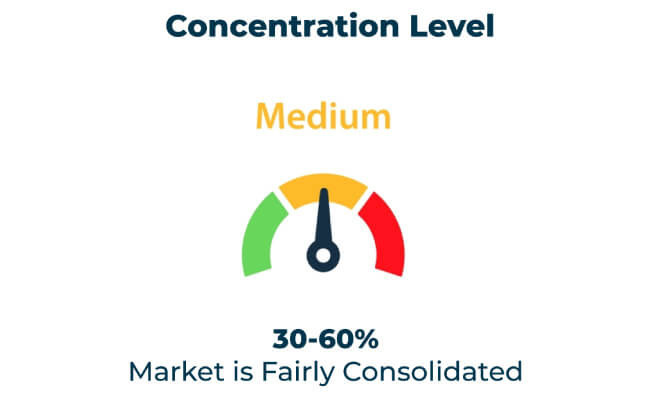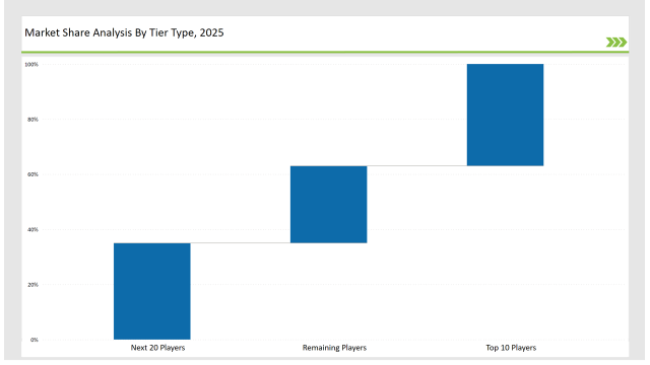The market for vacuum skin packaging (VSP) is thriving since businesses aggressively hunt for innovative ways to preserve foods, shelf appearance, and shelf life extension of products. The demand for vacuum skin packaging has been increasing due to its functionality in maintaining product integrity, conserving food wastage, and enhancing presentation and is in the food, pharma, and industrial industries. Producers are heavily investing in high-barrier films, sustainable materials, and intelligent sealing solutions to make the products safer and more sustainable.
Firms are developing innovations in modified atmosphere packaging (MAP), reusable vacuum-sealed films, and smart packaging to meet regulatory demands and shifting consumer trends. A paradigm shift within the industry also exists towards light, flexible, and sustainable vacuum skin packaging for attaining sustainability and reducing carbon footprints.
Tier-1 companies such as Sealed Air, Amcor, and Winpak occupy 37% of the market because they dominate high-performance vacuum-sealed films, have extensive international distribution, and are food-packaging innovation experts.
Tier-2 players such as Berry Global, Coveris, and Mondi Group control 35% of the market because they provide cost-effective and tailor-made sustainable vacuum skin packaging solutions for food and industrial use.
Tier-3 comprises regional and niche players who are involved in biodegradable vacuum skin films, high-barrier coatings, and specialized packaging formats with a market share of 28%. These players practice localized production, sustainable innovation, and tailor-made packaging design.
Global Market Share by Key Players (2025)
| Category | Market Share (%) |
|---|---|
| Top 3 (Sealed Air, Amcor, Winpak) | 18% |
| Rest of Top 5 (Berry Global, Coveris) | 12% |
| Next 5 of Top 10 (Mondi Group, Schur Flexibles, Linpac Packaging, Plastopil, ULMA Packaging) | 7% |

The vacuum skin packaging industry serves multiple sectors where freshness, product security, and shelf visibility are essential. Companies are developing innovative vacuum skin packaging solutions to enhance food safety and efficiency in the supply chain.
Manufacturers are optimizing vacuum skin packaging with advanced sealing technology, high-barrier films, and recyclable materials.
Sustainability and greater automation are changing the vacuum skin packaging sector. AI-augmented quality assurance, green packaging films, and automated vacuum-sealing systems are all being adopted to enhance production efficiency. Companies are developing high-barrier, recyclable vacuum skin packaging to substitute for conventional plastic packaging. Producers are enhancing their modified atmosphere packaging (MAP) offerings to optimize product freshness and security. They are also deploying solutions for digital authentication and smart tracking to have product compliance verified and allow for greater visibility across the supply chain.
Year-on-Year Leaders
Technology suppliers should focus on automation, sustainable materials, and digital monitoring to support the evolving vacuum skin packaging market. Partnering with food processors, pharmaceutical companies, and logistics firms will accelerate adoption.
| Tier Type | Example of Key Players |
|---|---|
| Tier 1 | Sealed Air, Amcor, Winpak |
| Tier 2 | Berry Global, Coveris, Mondi Group |
| Tier 3 | Schur Flexibles, Linpac Packaging, Plastopil, ULMA Packaging |

Leading manufacturers are advancing vacuum skin packaging technology with smart monitoring, biodegradable materials, and high-efficiency sealing solutions.
| Manufacturer | Latest Developments |
|---|---|
| Sealed Air | Launched recyclable vacuum skin packaging in March 2024. |
| Amcor | Developed AI-powered automated vacuum skin sealing in April 2024. |
| Winpak | Expanded sustainable vacuum-sealed films in May 2024. |
| Berry Global | Released biodegradable vacuum skin packaging for meat in June 2024. |
| Coveris | Strengthened MAP-based vacuum skin packaging in July 2024. |
| Mondi Group | Introduced resealable compostable vacuum skin pouches in August 2024. |
| Schur Flexibles | Pioneered RFID-enabled smart vacuum packaging in September 2024. |
The vacuum skin packaging market is evolving as companies invest in sustainability, automation, and smart packaging technologies.
The industry will continue integrating AI-enabled sealing systems into intelligent tracking and high-barrier sustainable films. Manufacturers will work on making vacuum skin packaging both compostable and recyclable to meet future environmental requirements. Intelligent packaging would be furthered by incorporating temperature and freshness sensors in packaging for both sellers and the end consumers. It would also work for maximizing the level of automation in vacuum skin packaging production to improve efficiency. Increased digitization will enhance traceability through digital authentication. Enterprises will also make forward strides with potential cost-effective innovation to bring value addition and make it accessible to emerging consumers.
Leading players include Sealed Air, Amcor, Winpak, Berry Global, Coveris, Mondi Group, and Schur Flexibles.
The top 3 players collectively control 18% of the global market.
The market shows medium concentration, with top players holding 37%.
Key drivers include sustainability, smart packaging, automation, and food safety.






Our Research Products

The "Full Research Suite" delivers actionable market intel, deep dives on markets or technologies, so clients act faster, cut risk, and unlock growth.

The Leaderboard benchmarks and ranks top vendors, classifying them as Established Leaders, Leading Challengers, or Disruptors & Challengers.

Locates where complements amplify value and substitutes erode it, forecasting net impact by horizon

We deliver granular, decision-grade intel: market sizing, 5-year forecasts, pricing, adoption, usage, revenue, and operational KPIs—plus competitor tracking, regulation, and value chains—across 60 countries broadly.

Spot the shifts before they hit your P&L. We track inflection points, adoption curves, pricing moves, and ecosystem plays to show where demand is heading, why it is changing, and what to do next across high-growth markets and disruptive tech

Real-time reads of user behavior. We track shifting priorities, perceptions of today’s and next-gen services, and provider experience, then pace how fast tech moves from trial to adoption, blending buyer, consumer, and channel inputs with social signals (#WhySwitch, #UX).

Partner with our analyst team to build a custom report designed around your business priorities. From analysing market trends to assessing competitors or crafting bespoke datasets, we tailor insights to your needs.
Supplier Intelligence
Discovery & Profiling
Capacity & Footprint
Performance & Risk
Compliance & Governance
Commercial Readiness
Who Supplies Whom
Scorecards & Shortlists
Playbooks & Docs
Category Intelligence
Definition & Scope
Demand & Use Cases
Cost Drivers
Market Structure
Supply Chain Map
Trade & Policy
Operating Norms
Deliverables
Buyer Intelligence
Account Basics
Spend & Scope
Procurement Model
Vendor Requirements
Terms & Policies
Entry Strategy
Pain Points & Triggers
Outputs
Pricing Analysis
Benchmarks
Trends
Should-Cost
Indexation
Landed Cost
Commercial Terms
Deliverables
Brand Analysis
Positioning & Value Prop
Share & Presence
Customer Evidence
Go-to-Market
Digital & Reputation
Compliance & Trust
KPIs & Gaps
Outputs
Full Research Suite comprises of:
Market outlook & trends analysis
Interviews & case studies
Strategic recommendations
Vendor profiles & capabilities analysis
5-year forecasts
8 regions and 60+ country-level data splits
Market segment data splits
12 months of continuous data updates
DELIVERED AS:
PDF EXCEL ONLINE
Vacuum Products for Emergency Services Market Size and Share Forecast Outlook 2025 to 2035
Vacuum Fiber Feedthrough Flanges Market Size and Share Forecast Outlook 2025 to 2035
Vacuum Tension Rolls Market Size and Share Forecast Outlook 2025 to 2035
Vacuum Self-priming Mobile Pumping Station Market Size and Share Forecast Outlook 2025 to 2035
Vacuum-Refill Units Market Analysis - Size and Share Forecast Outlook 2025 to 2035
Vacuum Leak Detectors Market Size and Share Forecast Outlook 2025 to 2035
Vacuum Insulation Panels Market Size and Share Forecast Outlook 2025 to 2035
Vacuum Pressure Encapsulated Transformer Market Size and Share Forecast Outlook 2025 to 2035
Vacuum Insulated Medium Voltage Switchgear Market Size and Share Forecast Outlook 2025 to 2035
Vacuum Rated Motors Market Size and Share Forecast Outlook 2025 to 2035
Vacuum Concentrators Market Size and Share Forecast Outlook 2025 to 2035
Vacuum Insulated Low Voltage Commercial Switchgear Market Size and Share Forecast Outlook 2025 to 2035
Vacuum Pressure Impregnated (VPI) Transformer Market Size and Share Forecast Outlook 2025 to 2035
Vacuum Insulated Pipe Market Size and Share Forecast Outlook 2025 to 2035
Vacuum Therapy Devices Market Size and Share Forecast Outlook 2025 to 2035
Vacuum Pressure Swing Adsorption Market Size and Share Forecast Outlook 2025 to 2035
Vacuum Grease Market Size and Share Forecast Outlook 2025 to 2035
Vacuum Truck Market Size and Share Forecast Outlook 2025 to 2035
Vacuum Insulated Switchgear Market Size and Share Forecast Outlook 2025 to 2035
Vacuum Sealing Machine Market Size and Share Forecast Outlook 2025 to 2035

Thank you!
You will receive an email from our Business Development Manager. Please be sure to check your SPAM/JUNK folder too.
Chat With
MaRIA